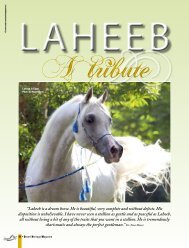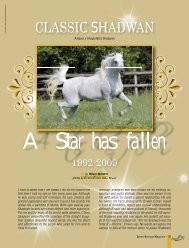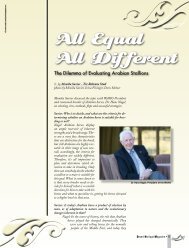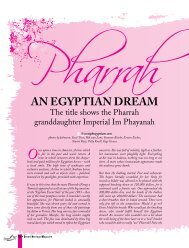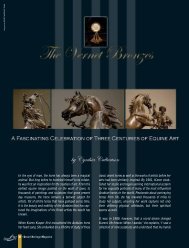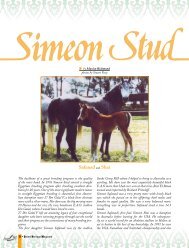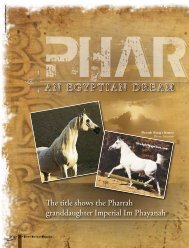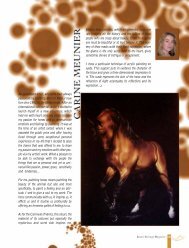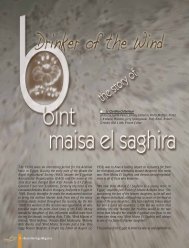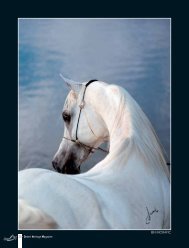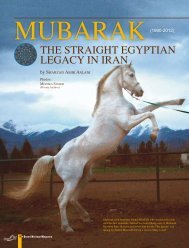n.8 - Desertheritagemagazine.com desert heritage magazine
n.8 - Desertheritagemagazine.com desert heritage magazine
n.8 - Desertheritagemagazine.com desert heritage magazine
You also want an ePaper? Increase the reach of your titles
YUMPU automatically turns print PDFs into web optimized ePapers that Google loves.
150 • Desert Heritage Magazine
y Pat Canfield<br />
photos by Nasr Marei<br />
LIVING COLOURS<br />
OF EGYPT<br />
The Western Desert<br />
Kharga & Dakhla<br />
“Desert” A word which<br />
immediately creates images in<br />
our minds of a vast expanse of<br />
barren rocks and moving sand<br />
dunes which flow along the<br />
horizon until they meet with<br />
an azure blue sky at what looks<br />
like the ends of the earth.<br />
Hundreds of millions of years<br />
of history are frozen in time in<br />
a place like this. In Egypt, the<br />
Great Western Desert, which<br />
begins at the west bank of the<br />
Nile and joins with the Sahara<br />
Desert, is one of the largest<br />
<strong>desert</strong>s and sparsely inhabited<br />
places in the world.<br />
Designed by DESERT HERITAGE TEAM
Even though there is an<br />
appearance of no life at all,<br />
there are actually traces of<br />
inhabitation since earliest<br />
recorded history.<br />
Throughout the Desert, we<br />
have prehistoric artifacts as<br />
152 • Desert Heritage Magazine<br />
well as remains from Pharaonic Egypt, Roman occupation,<br />
Medieval trade routes, and Bedouin tribes including today's<br />
camel caravans which still travel the “Darb El Arba'in”, the<br />
forty-day camel route between Sudan and the Nile valley.
And yet, even in this<br />
<strong>desert</strong>, one of the most<br />
unwel<strong>com</strong>ing places on<br />
earth, there are “Oases”<br />
thriving, vibrant settlements<br />
of people whose<br />
families may stretch<br />
back through centuries<br />
on the same land.<br />
Kharga, the largest and<br />
southern-most oasis is<br />
the most developed of<br />
the seven. In this place<br />
of extraordinary winds,<br />
heat and arid land we<br />
find a thriving <strong>com</strong>munity<br />
of farming people<br />
who produce crops of<br />
dates, wheat, rice and<br />
vegetables which are<br />
sold throughout the<br />
Nile valley.
156 • Desert Heritage Magazine
Another vital segment of<br />
Kharga Oasis is its traditional<br />
crafts, which share design patterns<br />
with the other southern<br />
oases. Embroidery, baskets<br />
and pottery all have a function<br />
in the daily life of the people<br />
and also have a great appeal to<br />
a growing tourist industry.<br />
Ruins of some Roman forts,<br />
late Pharaonic temples and<br />
early Christian sites provide a<br />
fascinating overlay to the<br />
towns and villages. Kharga<br />
was even a remote place of<br />
banishment for troublesome<br />
clergy during the Roman and<br />
early Christian times.<br />
Desert Heritage Magazine • 157
As you travel north from Kharga after one hundred and<br />
fifty kilometers, you reach the oasis of Dakhla. Here, in<br />
addition to pre-historic remains, we can find ruins going<br />
back to the Old and Middle Kingdom of Pharaonic Egypt.<br />
Today, this oasis is important for many of the same crops<br />
that were grown during the earliest of historic times.<br />
In the <strong>desert</strong> - one always holds the possibility of surprise.<br />
It may be a wink of a red flower in the shadow of a sprawling<br />
sand dune. It might be a verdant grove of date palm<br />
trees framing a natural turquoise blue spring of water. It<br />
could be a smile from a child peeking from behind a bright<br />
blue wooden shutter. No matter what the gift of expected<br />
delight - we may be sure that it will be a quiet pleasure and<br />
always a living colour of the Desert of Egypt.<br />
The route between Kharga and Dakhla is a microcosm of<br />
the history of that area. Ruins of Roman forts are scattered<br />
among pre-historic remains and caves with inscriptions<br />
carved into the rock where hermits often lived for<br />
many years. Buried Pharaonic remnants form the base<br />
for Christian and Islamic settlements. The Roman forts<br />
served as refuge for travelers as well as for defense. Wells<br />
from that time are still in use today.<br />
At Hibis, two kilometers north of Kharga, stands the<br />
Pharaonic Temple of Amun Re which was built by the<br />
Persian ruler, Darius in the 26th Dynasty. The monumental<br />
sandstone portal and surrounding walls may have<br />
been built over the remains of earlier structures and were<br />
certainly enlarged in Ptolemaic times.
Desert Heritage Magazine • 159
A short distance from<br />
Hibis you reach the<br />
ancient cemetery of<br />
Baghawat, possibly the<br />
earliest and best-preserved<br />
Christian cemetery<br />
in the world. The<br />
expanse of domed<br />
mausoleums and<br />
underground galleries<br />
is well preserved until<br />
today. Two hundred<br />
and sixty three tombs<br />
provide a tremendous<br />
archive of burials from<br />
single rooms to family<br />
tombs. They are beautifully<br />
constructed with<br />
domed enclosures,<br />
arched and columned<br />
chambers.<br />
Throughout the oases,<br />
life continues with<br />
exploration of the past<br />
along with enjoyment<br />
of today's dwellers.<br />
The people of this<br />
region have learned<br />
through the centuries<br />
to respect their environment<br />
and yet to<br />
over<strong>com</strong>e its hardships<br />
and forge lives of contentment<br />
and joy in<br />
each other and their<br />
world of many colours.<br />
160 • Desert Heritage Magazine
Desert Heritage Magazine • 161
Life in today's <strong>desert</strong> is grouped<br />
into Bedouins who still live a<br />
nomadic life of sorts with some<br />
habitation on the edges of the<br />
oases and farmers who live within<br />
the agricultural settlements. The<br />
houses in these villages are built to<br />
withstand the ordeal of the heat,<br />
sands and wind. The villages are<br />
labyrinths of natural looking houses<br />
which blend into the surroundings.<br />
They are built with very<br />
thick walls of mud brick - formed<br />
from mud and straw - and plastered<br />
over in stucco. Small-latticed<br />
wooden windows protect the interiors<br />
of the home from raging<br />
storms and dust. In some towns,<br />
upper floors are added and heavy<br />
wooden doors fit closely against<br />
rounded doorframes to protect<br />
against encroaching sands. Painted<br />
wooden doors and Arabic medallions<br />
with calligraphy serve to<br />
decorate and bless the dwellers<br />
with scenes from the Hajj, the<br />
Pilgrimage to Mecca.<br />
Balat and Bashindi are two of the<br />
villages on the route between oases<br />
which show Christian and Islamic<br />
settlements built over ancient sites.<br />
Balat in particular shows the use of<br />
covered streets and pathways<br />
which also prevented marauders<br />
from attacking on horseback.<br />
162 • Desert Heritage Magazine
The life in these settlements centers around the women and<br />
their daily work. As in all closely-knit <strong>com</strong>munities, daily chores<br />
are done together. Bright colours and fabrics bring joy to<br />
their world. The time-honored dress of the oases has disappeared<br />
in many areas but is still maintained through some of<br />
the families. Traditional black dresses are beautifully embroidered<br />
by precise cross-stitching which runs in strips down the<br />
arms, around the hem and most especially framing the bodice.<br />
Tassels, old coins and buttons are used to accent the patterns.<br />
Desert Heritage Magazine • 163
164 • Desert Heritage Magazine<br />
Rugs are usually<br />
of a kelim type.<br />
They are woven<br />
in geometric patterns<br />
of red,<br />
orange, black and<br />
white. The pieces<br />
are done in<br />
long strips on<br />
horizontal looms<br />
and are then stitched<br />
together to<br />
make the full rug.<br />
The natural dyes<br />
in the wool fibers<br />
allow the families<br />
to use the pieces<br />
for many years<br />
and then recycle<br />
them.
Baskets are woven from palm fronds and twine. Their shape is dictated by their purpose in the<br />
daily lives of the people. They are used for everything from carrying crops and lunch to the<br />
fields to a trousseau basket for brides. In Dakhla, in particular, they add special decorative touches<br />
in the form of ribbons, wool and tassels. Throughout the oases, the people forge a life of<br />
vibrant joy among the living colours of their sometimes desolate world.<br />
Desert Heritage Magazine • 165



